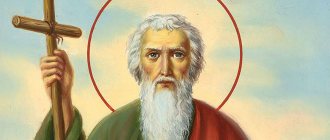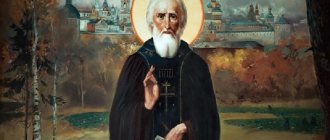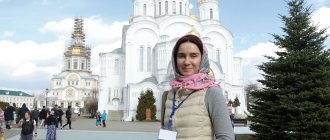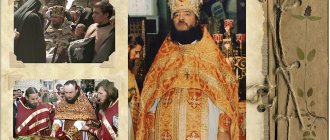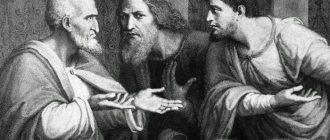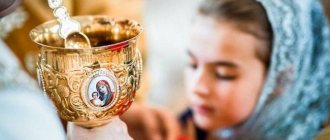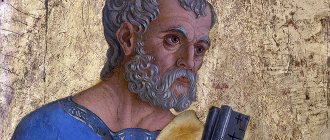A short biography of Andrew the First-Called describes how a simple fisherman became an apostle of Christ. Together with other witnesses of the Resurrection of his Teacher, the apostle - which means witness - fermented the entire universe with a new saving faith, unprecedented and unthinkable before. This was such an innovation that everyone who Andrei met was inflamed with either love and devotion to God, or rejection and hatred. Apostle Andrew the First-Called was the one who enlightened you and me through his mission in modern Ukraine and Russia. Today, many places in Crimea still testify to this - even the temples that the apostle himself began to build have been preserved.
The Apostle Andrew was a Galilean, a fellow countryman of the sons of Zebedee - the apostles John and James. Having first become a disciple of John the Baptist, he was the first to respond to the Savior’s call to preach. Due to the fact that he was given the honor of being the first to follow Christ, he was nicknamed the First-Called. The future apostle follows the Messiah, preceding John and Peter.
Life of St. Andrew the First-Called
Andrew the First-Called lived in the north of the Holy Land in an area called Galilee. Since the area bordered Greece, there was a lot of communication between the two peoples. That’s why Andrei got his Greek name, which means “Courageous.” From his youth, the future apostle retained chastity and his ardent desire to serve God; he first responded to the preaching of John the Baptist and was one of his disciples. After the baptism of Christ and the Forerunner’s instructions about Him that “behold the Lamb of God who takes away the sins of the world,” the Apostle Andrew, without hesitation, followed Him. With him was John, the future beloved disciple of Christ. This is how the first four apostles appeared: Andrew called his brother, the future apostle Peter, and now just Simon, and John called James: “We have found the Messiah!”
Saint Andrew the First-Called was with Christ from the very beginning of his preaching, and until the last: he was with him during the revelation by the Lord about the destinies of the world, he told who had five loaves of bread and two fish before the miracle of multiplication. He was with Him on the Mount of Olives, where Christ ascended to heaven after His Resurrection.
According to the Savior’s promise, on the 50th day after His Ascension the Holy Spirit descended on the apostles and the Mother of God. The apostles, after being enlightened by grace and filled with many Holy gifts, went out to preach. In the upper room of Zion they cast lots - who should go to preach in what country. Apostle Andrew inherited our lands - the north of the Black Sea. In his wanderings, he reached the future Kyiv, where he planted a cross and predicted that the Lord would enlighten this land with Holy Baptism and erect many churches on it.
After returning to Greece, for many healings and conversions to Christianity, the Apostle Andrew shared the fate of most of the other apostles: he was crucified by the wicked pagan ruler. But he was crucified in such a way that his torment would last longer. To do this, they tied him to a cross resembling the letter X, without nailing him down, so that the saint would not die quickly. After two days of suffering, the apostle went to the Lord in prayer and those present saw how a bright light illuminated the cross with the martyr and in this radiance he betrayed his soul.
History of the Holy Apostle
Andrew the First-Called became the first person to respond to the call of the teacher Jesus Christ to follow him, and therefore was awarded the name First-Called. With their brother, they grew up in a small town, where they became acquainted with the speeches of John the Baptist; by mistake, they considered him the Anointed One, whom the nations were waiting for.
The humble minister rejected their assumptions, leading the men to the real Messiah. They immediately accepted the truth he carried. And Andrei, filled with the truth, told Peter about it, who selflessly followed with them. But before they followed the Lord, they were ordered to return to their homes and complete the necessary tasks related to work and housekeeping. Jesus, catching them fishing, which was usual for men of that time, calls on them to go with him and become “fishers of men.”
As believers know, in the end, each apostle received the gifts of the Holy Spirit, that is, he had miraculous abilities. Each of them knew how to heal and perform other miracles. They continue this activity to this day. Therefore, the icon of St. Andrew the First-Called helps those praying in many ways: it heals ailments, improves relationships, and strengthens faith.
Veneration of Saint Andrew the First-Called
The saint's memorial day was established by the Orthodox Church on December 13, and by the Catholic Church on November 30.
Apostle Andrew is considered the patron saint of the Russian Church, since it, the direct heir of Byzantium, took over the succession that the Church of Constantinople led from Andrew the First-Called.
In Russia, his memory was always solemnly celebrated - to a greater extent before the revolution. Peter 1 introduced special veneration - the highest award order named after him and approved the St. Andrew's flag, under which many victories were accomplished. The flag depicts an X-shaped cross - blue on a white background - on which the apostle was crucified.
The relics of Saint Andrew are kept in the Greek city of Patras, at the site of the apostle’s crucifixion. In 1974, a grandiose cathedral named after him, known throughout the world, was erected here.
Memorial Day of the Apostle Andrew - December 13
Orthodox Christians celebrate the Day of Remembrance of St. Andrew the First-Called on December 13. In all churches they read prayers to him, preach sermons glorifying his feat in the name of Christ. Children born on this day are baptized under the name Andrey.
There are signs that tell you what you can do and what you can’t do on this day. The Church classifies them as superstitions, and people still follow them.
For example, it is believed that on St. Andrew's Day it is forbidden to sew, weave and spin. Moreover, such a ban on practicing a craft extends up to Epiphany.
Christmas fortune telling. I.N. Kramskoy. 1870 Despite the fact that the Church prohibits fortune telling, in Russia they do fortune telling on major holidays, for example, Christmastide or St. Andrew's Day
These are popular prohibitions, but the Church has established its own. The fact is that the night from November 12 to 13 is popularly considered magical, since the Slavic tribes held celebrations during this period in honor of the end of the agricultural year.
That is why it is customary to guess at this time. The Church, fighting superstitions, established a categorical ban on fortune telling on this day.
The cross on which St. Apostle Andrew the First-Called suffered. Patras
There is a sign that those who especially actively celebrate St. Andrew's Day will have a good harvest next year. At the same time, the Orthodox should celebrate it in prayer by visiting church, confessing and receiving communion.
It is necessary to refrain from violent celebrations on this day, in memory of the suffering that the apostle endured for the Glory of God.
By leaving a comment, you accept the user agreement
Andrew the First-Called: what do they pray for?
Andrew the First-Called is the patron saint of Ukraine and Russia, as well as other countries located in the territory where he preached: these are modern Greece, Turkey, Macedonia, Asia Minor. He also patronizes fishermen and sailors. St. Andrew's battle flag is known throughout the world: since the 17th century it has been the state flag of the Russian navy. They pray to Andrew the First-Called for conversion to the holy faith, for success in the defense of the fatherland, for the well-being of sailors.
From Holy Tradition there are known cases of not just trouble-free healing, but also the resurrection of people by Andrew: like the other apostles, he repeatedly used the gift of Christ and brought people back to life. Therefore, you can pray to him for healing from illnesses.
At the site of his martyrdom, a spring filled with water that had the ability to heal. Now there is a huge cathedral named after him. Famous for its splendor, it took almost 60 years to build.
Apostle James Zebedee
The name Jacob, very popular in Judea at that time, was borne by two of the apostles. One of them was the son of Zebedee and the elder brother of the Apostle John. Like Simon and Andrew, these brothers were also fishermen on Lake Galilee, and their calling looked very similar: at the first call, they abandoned everything and followed Jesus. Unlike the other James, John's brother is sometimes called James the Elder.
He, along with Peter and John, was part of the circle of his closest disciples - for example, only the three of them were present on the mountain during the Transfiguration of the Lord, at the resurrection of Jairus’s daughter and during the intense prayer of Jesus in the Garden of Gethsemane. However, Jacob is always the third in such stories; he is mentioned along with others, but does not play an independent role. This is how it always happens in life: some people get less fame than others.
Jesus is later than the brothers not only by the sons of Zebedee, but also by the Aramaic word “Boanerges”, i.e. "sons of thunder" for their hot character. It was they who wanted to bring fire down on the Samaritan village and asked permission to sit on the right and left sides of Jesus when He came in His Kingdom.
But, unlike John, Jacob was not destined to live a long life. He was executed by King Herod Agrippa in 44, shortly after the start of his apostolic preaching. Of all the apostles, only his death is reported by the book of Acts and the New Testament in general. He did not take first place during his life, but he was the first to accept death for the Gospel.
Prayer to St. Andrew the First-Called
The memory of Saint Andrew the First-Called is honored with prayer. Believers pray for healing and health.
Prayer to Saint Andrew the First-Called
First-called Apostle of God and our Savior Jesus Christ, supreme follower of the Church, all-validated Andrew! We glorify and magnify your apostolic works, we sweetly remember your blessed coming to us, we bless your honorable suffering, which you endured for Christ, we kiss your sacred relics, we honor your holy memory and believe that the Lord lives, and your soul lives, too. You remain with us forever in heaven, where you do not forsake us with your love, as you loved our fathers, when through the Holy Spirit you saw our land turning to Christ. We believe, as God prayed for us; in His light all our needs are in vain. Thus we confess this faith of ours in your temple, and we pray to the Lord and God and our Savior Jesus Christ, that through your prayers he will give us everything we need for the salvation of us sinners: as you abied the voice of the Lord, forsake your fears; and let each one of us seek not his own, but for the building up of his neighbor, and let him think about a higher calling. Having you as an intercessor and prayer book for us, we hope that your prayer can accomplish much before our Lord and Savior Jesus Christ, to Him belongs all glory, honor and worship with the Father and the Holy Spirit forever and ever. Amen.
Troparion to St. Andrew the First-Called
As the first-called and supremely existing brother of the Apostles, Andrei, the Lord of all, pray to grant greater peace to the universe and great mercy to our souls.
Kontakion to St. Andrew the First-Called
Voice 2
Let us praise the courage of the same-named eulogist and the Church's supreme successor, Peter's kinsman, just as in ancient times we have cried out to us: come, you who have found the Desired.
Briefly examining the biography of Andrew the First-Called, we see a courageous man, fearless in the face of inhuman trials: preaching among wild, barbaric peoples was doubly courageous if we remember the customs of wild pagans. But the love of Christ burned in his heart and, therefore, today we are enlightened by the faith of Christ. Let us appreciate the merits of our patron, and remember his life, which is so instructive for us.
Tatar Khan Edigei besieged Moscow, but could not take it
Discussion: 12 comments
- Alexey Sorokin:
12/13/2007 at 00:00Happy Holidays! God bless you!
- A. Turik:
12/13/2007 at 00:00
Happy holiday, friends! In this regard, we must remember that the last Russian state formation on the territory of historical Russia - the Amur Region, headed by General M.K. Diterichs, and proclaiming the restoration of the Tsarist Autocracy and the Zemsky Sobor, had as its state banner the St. Andrew's Banner. It is the St. Andrew's flag that is the White Banner we are talking about. Higher the White Banner!
- R. B. Pavel:
12/14/2007 at 00:00
Happy Holidays, brothers!
- R.B.Dimitri:
12/14/2008 at 00:00
Pray to God for us, Holy Apostle Andrew.
- Elena Zaitseva:
07/11/2009 at 00:00
Every Orthodox Russian needs to know the history of our state and the history of the Russian Orthodox Church. God bless us!
- Svyatoslav:
12/13/2009 at 00:00
Happy holiday, brothers! Through the prayers of the saints, may the Lord deliver the Russian land from dishonor. The Tsar is coming!
- Valery Mikhailovich-Elena Zaitseva:
12/13/2009 at 00:00
You are very right when you say that every Russian should know our history. I would add to this that we must not forget its history, like this, for example:
“1760 - The adopted law gave the landowner the right to exile serfs to Siberia for settlement, counting them as recruits, and then (by decree of 1763) even to hard labor. At the same time, the law increasingly depersonalized the serf, erasing from him the last signs of a legally capable person. The landowner traded him as a living commodity; the right to voluntarily enroll as a soldier was closed; the peasant did not have the right to enter into a guarantee and could not be obligated by bills of exchange; finally, at the beginning of the reign of Catherine 1, the serfs lost the right to complain about their masters.”
- Sergey:
11/16/2010 at 00:00
I myself wear the saint around my neck and study his history and believe in him!
- Sergey:
11/22/2010 at 00:00
I wear an icon on a leather cord with the Apostle Andrew the First-Called and I sacredly believe in him!!!!!!!!!!!
- Natalya:
12/12/2010 at 00:00
Uvazhayemiye brat'ya i syostry, uverena, what mnogikh iz vas zainteresuyet etot nauchnyi material—https://runitsa.ru/publications/publication_419.php .
- Patriot_7:
12/13/2011 at 00:00
Apostle Andrew /First-Called/ from XII, came from the Galilean city of Bethsaida. The son of John, brother of the Apostle Peter, was first a disciple of John the Baptist, then followed in the footsteps of Christ. Andrew's collaborators were: Stachy, Amplius, Urban, Narcissus, Apellius and Aristobulus, who became Bishops, where St. Andrew left them. One of his students was the Greek mathematician and philosopher Stratocles, who became the first Bishop of Patras. The Apostle Andrew was crucified in Patras, on the X-cross on December 13, 102, by proconsul Aegeates. He preached in Samaria, Gaza, Lida, Antioch, Edessa (now Urfa in Turkey). Further in Epirus, Peloponnese, Argos, where he put the sophists to shame, he left Bishop St. Stachys in Byzantium. Then in Bithynia, Cappadocia, Galatia and in the territory of Pontus, in what is now Northern Turkey. On his first journey after Pontus, Andrei passed through Armenia, Abkhazia, Ossetia, Georgia, where, at the Borjomi Gorge in Atskhur, he founded the Temple and left the Icon of the Mother of God. This image was located in the Nativity of the Virgin Mary Gaenata Monastery in Kutaisi. Andrei left the icon of the Savior in Klarjeti, in the Achinsk Cathedral Church. It is kept in the State Museum of Arts of Georgia. Then he went to Rus', in the footsteps of the grandchildren of Japheth, establishing Bishops in Krasnodar /Tmutarakan/, Rostov-on-Don /Tanais/, Voronezh /Voronzhenets/, founded the Spassky Cave Monastery in the village of Kostomarovo, Voronezh region, Venevsky Monastery in the Tula region, going to the limits Moscow region returned to Jerusalem! On the second trip, he sailed from Jerusalem to Ephesus, where he met with the Evangelist St. John. Along the way, I spent several days on the island of Cyprus. The place where he waited for the ship is now called Cape St. Andrew. After Ephesus he returned to Antioch, then went to Nicaea, and then visited Pontus and Georgia. Further, his path lay through Kurdistan to Parthia /Persia/ and to the Gedrosia desert /present-day Balochistan, not far from the Pakistan-Iran border/. Then Andrey went through the territory of Pakistan and Afghanistan along the Silk Road to Sogdiana / modern Samarkand and Bukhara /. From there to the lands of the Scythians-Massagets and Massaks /between Mongolia, Kazakhstan and Altai, where modern Bulgarians and Turks came from/, Ungros and Troachians, and also visited the Halbin Mountains /Siberia/ - the lands of Eastern Scythia. On the Ural Mountains, Andrei reached the place where the village of Kazanskoe now stands, in which there is a temple dedicated to St. Andrei. From Altai, Andrei walked a different route - to the Caspian / Hyrcanian / Sea, crossing the Volga / Ra / to the Alans. From there to Kurdistan, and to Jerusalem. Andrei placed large stone and iron crosses everywhere. He had a wonderful sense of humor. After the Dormition of the Mother of God in 57, Andrei set off on his third journey to the North. He visited Pontus, went to Georgia and to the Sea of Azov, and from there to the Crimea and then up the Dnieper to present-day Kyiv. He installed Bishops in Kyiv, Pskov, Novgorod. Having seen Russian baths in Novgorod, he wrote to friends: “The Slavs are so strange - they torment themselves with birch brooms.” On the island of Valaam, Andrei left St. Sergius, who founded the Valaam monastery and baptized the local resident Mung, who became St. Herman. From the island of Valaam, Andrei moved with reindeer herders to the Solovetsky Islands. Returning from Solovki, Andrei visited all the Baltic countries and cities, thus sailing to Scotland. From Scotland through Germany, Poland, Slovenia he came to Romania, where he lived for 20 years and met with Emperor Trajan. Andrew's disciples - St. Inna, St. Pinn and St. Rome, baptized in Transnistria, Bukovina, Bezsarabia, Wallachia. From Romania, St. Andrew went to Crimea, Sinop, Macedonia, Epirus. From Epirus to Thessaly, Lamia, and then to Loutraki (there is a cave where he lived) and Corinth. After Corinth, two years in the Peloponnese, where he ended his earthly life on the cross in old age! The relics of St. Andrew and St. Luke from Patras in 367 were transferred to Constantinople by the Byzantine commander-in-chief Artemius, during the reign of Emperor Constantius /337+363/. At the same time, St. Regulus delivered a piece of the relics of St. Andrew to Scotland. After the sack of Constantinople, the crusaders brought the Holy relics to Amalfi /Italy/. But the honest head of the Apostle remained in Patras until the 15th century. Before the Turkish invasion, the rulers of Patras gave her to Rome. In 1964, the Catholic Church returned it to Patras to the Cathedral of St. Andrew. In addition to the Holy Head, there are several more particles of his Holy relics in Amalfi. In 1969, the Pope donated some particles to the Catholic Cathedral of St. Mark in Edinburgh, Scotland. The monks of the monastery of St. Andrew on the island of Kefalonia, not far from the shores of the Peloponnese, keep the foot of the Apostle, and in the monastery of St. Andrew there is a particle of his Holy Head. The Cross of St. Andrew the Apostle was taken from Greece by the Duke of Burgundy during the Crusades. In 1968, the cross returned to the Orthodox Cathedral in Patras.
- ***:
12/14/2014 at 00:00
Hasid Rabbi Beard (Museum of Tolerance, synagogue in Maryina Roshcha) was awarded the Order of St. Andrew the First-Called in the Grand Kremlin Palace!

